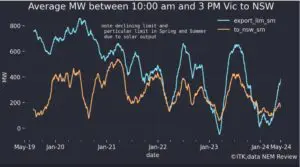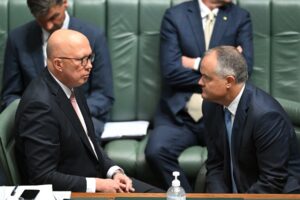Emissions data stamped on renewable energy certificates could boost demand for new renewables and storage, according to the Clean Energy Investor Group, while also showing how much fossil fuel generation they displace.
In its submission on the federal government’s plans to introduce a new certificate for voluntary buyers to be known as the REGO, the Renewable Electricity Guarantee of Origin, the CEIG is calling for the inclusion of data on the emissions intensity of the generation displaced by each megawatt-hour of renewable electricity.
The new REGO certificates are due to be introduced in 2025, and will coexist with Large-scale Generation Certifications and then replace them and the small-scale version from 2030.
The CEIG says despite issues around data – off-grid and remote systems may not be able to generate enough data to match their generation with what might otherwise have been used – being able to state the tangible benefit of renewable energy on a certificate would be a boost for building more generation and storage.
But the government is resisting the idea of stamping the new certificate with emissions intensity data, instead suggesting to add a timestamp to each document that shows when power is sent out by generator or energy storage system.
“There may not be sufficient data to allow the emissions intensity of electricity generation in off-grid and remote grid settings to be calculated for each hourly time interval,” the Department of Climate Change, Energy, the Environment and Water approach paper said in September.
“Noting the potential for misinterpretation of this data, data availability issues in some cases, and potential additional administrative complexity, the Department considers it would be preferable not to publish any emissions intensity information on REGO certificates.”
But the data is already available, said Pollination executive director Anna Hancock in RenewEconomy in July.
“The Australian Energy Market Operator produces a daily Carbon Dioxide Equivalent Intensity Index (CDEII) for the NEM. That index already contains data for each NEM State showing the tonnes of greenhouse gas emissions that can be displaced by each megawatt hour of renewable electricity,” she wrote.
“The CDEII could presumably be expanded to provide dispatch interval emissions intensity data for each state so that energy users can readily calculate their energy use emissions.
With this same data stamped on each REGO for each megawatt hour of renewable and zero emissions energy storage output, buyers could see how much their purchases reduce emissions.”
How to bring storage into the fold
The government wants the REGO scheme to be fit-for-purpose until as late as 2050 and therefore be able to encompass new types of energy, from offshore wind to energy storage systems.
However, the latter is already proving controversial, and challenging.
The proposed scheme will see batteries surrender REGOs for all of the electricity they absorb from the grid while charging, under the assumption that it’s impossible to split green from dirty energy.
They will then be able to claim REGOs for energy dispatched to the grid – which will be less than that used to charge because of network losses. Meaning even batteries that only charge from, say, a wind farm, will make a loss on REGOs because of the assumption that some of its charge is from fossil fuel electricity.
A solution, CEIG says, is to make the market voluntary to prevent strange market dynamics or discourage battery installations.
The inherent round-trip losses that come when charging and discharging batteries might disincentivise certificate trading as battery owners hold on to REGOs to cover the ones they’re forced to surrender.
And adding a second price signal from REGOs into the mix may mean battery owners stop responding to those from the NEM – charging from cheap clean energy during the day and discharging in the evenings and at night when fossil fuel power tends to dominate, the CEIG submission says.
What happens to below-baseline generators?
Then there is a seemingly minor but pivotal change the REGOs will make on the existing Renewable Energy Target (RET) scheme: including generation that was built before 1997.
The RET was built to encourage more renewable energy assets to be built, so it awarded certificates to anything built after a baseline set in 1997. Any generation built before that time wasn’t eligible for the certificates.
However, the government wants to include pre-1997 renewable generation in the REGO scheme so it isn’t used in other schemes and then “increase the risk of double counting of electricity”, but also wants to limit who can surrender them before 2030, and for what purpose.
CEIG says this would create a two-tier certificate system and suggests instead restricting the use of certificates from the few remaining pre-1997 renewable generators, or certificates created by specific named power plants, to the likes of emissions-intensive trade-exposed (EITE) activities.










